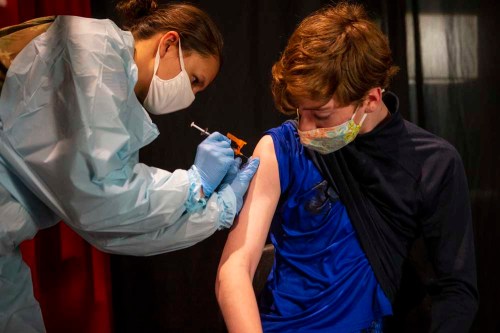Oregon should ‘start raising a ruckus’ over apparent unequal COVID-19 vaccine allocation from feds, state official says
Published 7:00 am Saturday, April 3, 2021

- Pendleton High School student Scott Train, right, watches as Specialist Stephanie Gonzalez, of the Oregon National Guard, administers a dose of the Pfizer-BioNTech COVID-19 vaccine during a vaccination clinic for high school students at Wildhorse Resort & Casino on March 17, 2021.
SALEM — Oregon’s top public health official urged the governor’s office last week to press the federal government to remedy an apparent widening disparity in the COVID-19 vaccine doses sent to Oregon compared to many other states.
If federal officials gave Oregon the same amount of vaccine doses per capita as California, Oregon could have likely vaccinated an additional 150,000 residents, Oregon Health Authority Director Patrick Allen wrote in a March 28 email to Gov. Kate Brown’s office.
At Kansas’ level, it could mean nearly 227,000 more Oregonians vaccinated with a first dose, according to Allen’s calculations. And at Wyoming’s rate, 370,000 additional Oregonians, Allen said.
Allen wrote about his struggles to get an explanation for what seems like an “extremely inequitable” process.
He didn’t know if the issue should be directed to the White House, the head of the federal COVID-19 vaccine response or to Oregon’s congressional delegation.
But, he advised, it seems “we at least need to start raising a ruckus.”
Oregon’s vaccine allocation from the federal government is coming into sharper focus following reporting by The Oregonian/OregonLive, which last month showed the state falling backward in shots administered compared to other states.
Oregon ranked 39th in doses administered per capita from Feb. 14 to March 14 despite receiving middle-of-the pack allocations at the time.
State officials had already been monitoring the allocation issue, but the newsroom’s reporting in part prompted additional inquiries, said David Baden, the health authority’s chief financial officer who oversees vaccine allocations.
“We had a couple of discussions about it, yes, but admittedly had not raised big alarm bells or had not pushed (federal officials) hard at that point,” Baden said of the apparent disparities in allocations. He said the news organization’s reporting reaffirmed “that is wasn’t just us seeing it ourselves, that you were seeing it as well in your reporting.”
After Allen highlighted the apparent disparities to the governor’s office, the governor’s office subsequently contacted the White House COVID-19 Response Team, Brown’s spokesperson Charles Boyle said in an email.
Boyle said several other governors also expressed concern about allocations falling short, too. That prompted a meeting on Thursday, April 1, with the Biden administration in which officials from Oregon and other states asked for greater transparency and explanations, Boyle said.
Boyle didn’t provide details when The Oregonian/OregonLive asked what was said during the discussion with federal officials, including whether they agreed with Oregon that there is a problem.
“We are continuing to monitor this situation, to ensure that Oregonians have fair access to the federal government’s vaccine supplies,” Boyle said.
The Oregonian/OregonLive last week asked the Centers for Disease Control and Prevention — which publishes online data tracking vaccines delivered and shots administered state by state — if it agreed there was a large gap in doses allocated per capita and, if so, why that’s happening and what the agency is doing to remedy it.
The CDC didn’t respond.
The agency’s website says vaccines are allocated based on the adult population of each state. The website also acknowledges factors that might lead to one state receiving more: doses that are sent directly by the federal government to tribes and federal entities, such as the Veterans Administration and military bases, for example.
Oregon’s public health officials say they don’t have detailed data to show if Oregon is getting shorted even after accounting for extra doses that went to tribes and other entities.
But it’s clear that more doses are going to states with, for example, high populations of indigenous people associated with tribes.
Alaska, with about 15% of its population who are Alaska Natives or Native Americans and a high proportion of military personnel, leads the nation in the highest per capita vaccine doses sent there — more than 84,000 per every 100,000 residents. Alaska also receives an entire month’s worth of shipments at once due to its remote location, skewing its numbers higher just after that shipment arrives.
Other states with sizable tribal populations, such as New Mexico and South Dakota, also received high per capita doses at about 71,000 to 72,000 doses per 100,000 residents.
All three states rank within the top 10 states in overall percentages of their residents partially and fully inoculated against the novel coronavirus.
Oregon, with just under 2% of its population identifying as Native American and relatively few military personnel, has received about 59,000 doses per 100,000 residents, ranking it 36th in per capita doses delivered by the federal government.
Allen said he suspects there’s a direct correlation between that and Oregon’s rank as 35th in the nation for the percent of residents who’ve received at least one shot.
Of the 34 states who’ve vaccinated larger proportions of their residents than Oregon, 30 of them had received more doses per capita from the federal government, according to the news organization’s analysis.
“We could be vaccinating faster, especially in the metro area, with more doses,” Allen said in his email.
The news organization found Allen’s general conclusions in his email to Brown’s office — that Oregon’s allocation appeared to lag behind many states — to be accurate and that Oregon could likely vaccinate more people with more doses even if some of his calculations in the number of additional people that could be inoculated was higher than an analysis by The Oregonian/OregonLive. That might be in part due to newer data that the news organization used.
As of April 1, nearly 1.2 million Oregonians are at least partially inoculated. That’s about 28% of the state’s population, 1 percentage point behind the national average.
But Oregon officials point out that even if Oregon’s performance in vaccinating people with first doses is slightly behind the national average, the state and its residents have done a good job of limiting coronavirus infections compared to most other states. Oregon has the fourth lowest number of cases and fifth lowest number of deaths since the pandemic began.
Baden, who oversees the state’s vaccine allocations, said if Oregon doesn’t get a satisfactory explanation and a plan of action, he expects the governor and Oregon’s congressional delegation to push for a remedy.
“We are most definitely following up … and really want to get to the bottom of what this is,” Baden said.









